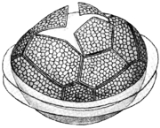
Corticata
Encyclopedia
Corticata in the classification of eukaryote
s (living organisms with a cell nucleus), is a clade
suggested by Cavalier-Smith to encompass the eukaryote supergroups of the following two groups:
It is not clear that it is indeed a clade (that is, containing all organisms descended from a common ancestor, and no others).
Eukaryote
A eukaryote is an organism whose cells contain complex structures enclosed within membranes. Eukaryotes may more formally be referred to as the taxon Eukarya or Eukaryota. The defining membrane-bound structure that sets eukaryotic cells apart from prokaryotic cells is the nucleus, or nuclear...
s (living organisms with a cell nucleus), is a clade
Clade
A clade is a group consisting of a species and all its descendants. In the terms of biological systematics, a clade is a single "branch" on the "tree of life". The idea that such a "natural group" of organisms should be grouped together and given a taxonomic name is central to biological...
suggested by Cavalier-Smith to encompass the eukaryote supergroups of the following two groups:
- Plantae, or ArchaeplastidaArchaeplastidaThe Archaeplastida are a major group of eukaryotes, comprising the red and green algae and the land plants, together with a small group called the glaucophytes. The plastids of all of these organisms are surrounded by two membranes, suggesting they developed directly from endosymbiotic...
(plantPlantPlants are living organisms belonging to the kingdom Plantae. Precise definitions of the kingdom vary, but as the term is used here, plants include familiar organisms such as trees, flowers, herbs, bushes, grasses, vines, ferns, mosses, and green algae. The group is also called green plants or...
s, red algaeRed algaeThe red algae are one of the oldest groups of eukaryotic algae, and also one of the largest, with about 5,000–6,000 species of mostly multicellular, marine algae, including many notable seaweeds...
, green algaeGreen algaeThe green algae are the large group of algae from which the embryophytes emerged. As such, they form a paraphyletic group, although the group including both green algae and embryophytes is monophyletic...
, and glaucophyteGlaucophyteThe glaucophytes, also known as glaucocystophytes or glaucocystids, are a small group of freshwater microscopic algae. Together with the red algae and green algae plus land plants , they form the Archaeplastida...
s) - Chromalveolata (a group including kelpKelpKelps are large seaweeds belonging to the brown algae in the order Laminariales. There are about 30 different genera....
, water mouldWater mouldOömycota or oömycetes form a distinct phylogenetic lineage of fungus-like eukaryotic microorganisms . They are filamentous, microscopic, absorptive organisms that reproduce both sexually and asexually...
s, ciliateCiliateThe ciliates are a group of protozoans characterized by the presence of hair-like organelles called cilia, which are identical in structure to flagella but typically shorter and present in much larger numbers with a different undulating pattern than flagella...
s, dinoflagellateDinoflagellateThe dinoflagellates are a large group of flagellate protists. Most are marine plankton, but they are common in fresh water habitats as well. Their populations are distributed depending on temperature, salinity, or depth...
s, and other organisms)
It is not clear that it is indeed a clade (that is, containing all organisms descended from a common ancestor, and no others).

